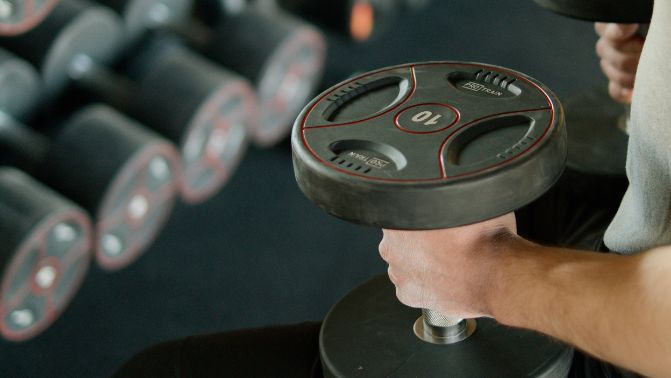Whether it is to improve your physique or to better your physical performance, there’s no reason not to include chest workouts in your gym routine.
The most common method of doing so is by lifting one massive barbell, but dumbbells are also a very good choice, especially for beginners or those who prefer the versatility of lighter weights. The use of two smaller weights allows for more possibilities of what you can do when compared to just one barbell, and in some regard, leads to more cumulative muscle mass gained.
That being said, what are the best chest workouts with dumbbells? Keep reading and find out.

Can you build your chest with only dumbbells?
Using dumbbells alone can actually provide a solid chest workout. To some extent, using two smaller dumbbells is better than using one massive barbell; researchers have discovered that your chest muscles become more activated through dumbbell exercises compared to barbell exercises.
However, that doesn’t mean you should exclude other types of chest exercises from your workout routine if you’re looking to optimize your gains. The smaller size of dumbbells can work as a way to complement or even lead up to the use of a barbell for better results, and you can squeeze in exercises like pushups to add more variety to your routine.

How many chest exercises should you do per week?
In general, training your chest muscles one to two times per week should suffice, especially if you’re just starting out. However, some people may need more depending on their goals and lifestyle. For example, athletes in certain sports and more experienced bodybuilders may need to work on their chest muscles up to three times per week, often incorporating chest exercises with various other types of workouts.

5 dumbbell exercises for your chest routine
Chest press
The dumbbell version of this classic resistance training exercise (which is usually performed with one larger barbell) focuses on strengthening the muscles at the very front of your chest. Though it ultimately does not matter if you lie back on a weight bench or an exercise ball to do chest presses, it is recommended to use a flat surface like the former if you’re just beginning.
Instructions:
- Lie on your back, holding a dumbbell in each hand. With your upper arms against the weight bench, you should be forming a 90-degree angle with your arms so your forearms are perpendicular to the floor.
- Slowly push upward to lift the weights until your elbows are straightened, and then slowly bring your arms back into the starting position.
- Perform 3 to 4 sets of 8 to 12 reps.
Incline chest press
While the normal “flat” chest press equally strengthens the upper and lower pectoral muscles, this variation focuses more on the upper part of your pecs. The incline also adds a little more challenge to it, taking advantage of progressive overload for more noticeable results. However, this means beginners will want to opt for lighter weight to prevent injury.
Instructions:
- Set a reclinable weight bench at a 15- to 30-degree angle upward.
- Lie on your back on the incline, holding a dumbbell in each hand. Your arms should form a 90-degree angle, with your upper arms in line with your shoulders.
- Tense up your abdominals and press the dumbbells up until your arms are fully extended. Pause here for a moment before slowly lowering the weights back down to the starting position.
- Perform 3 sets of 10 to 12 reps.
Decline chest press
This is the exact opposite of the incline chest press; this variation of the classic flat chest press instead targets the lower pectoral muscles at a reverse angle from the incline variant.
Instructions:
- Set a reclinable weight bench at a 15- to 30-degree angle downward.
- Lie on your back on the incline, holding a dumbbell in each hand. Again, with your upper arms against the weight bench, your elbows should be bent at a 90-degree angle and your palms facing forward.
- Slowly lift the weights up until your elbows are straightened, then gradually bring your arms back into the starting position.
- Perform 3 sets of 12 to 15 reps.
Chest flys
The chest fly exercise works differently from the chest exercises we covered before. Instead of pushing the dumbbells up and away from your chest, you bring each dumbbell from the sides to your midline. This allows you to target the muscles within your inner chest.
Instructions:
- Lie on your back, holding a dumbbell in each hand above your chest. They should be at your body’s midline, and you want your palms to be facing each other.
- Keep a slight bend in your elbows, and then slowly bring your arms out and down. When your arms are parallel with the floor, pause for a moment.
- While squeezing your pectoral muscles, bring your arms back to the starting position in a gesture that resembles a hug. Try to avoid having the dumbbells collide with each other at the top.
- Repeat for 3 sets of 12 to 15 reps.
Straight arm pullovers
Unlike the rest of the chest exercises here, the straight arm pullover focuses on not just your chest muscles but also on your core and arms. This makes it a viable exercise to integrate into a total body workout routine, but it’s also fine to do it if you’re focusing primarily on your chest.
Instructions:
- Lie on your back, holding a dumbbell in each hand above your chest at arm’s length. They should be at your body’s midline with straight elbows. Your head should also be either over or at the edge of the weight bench.
- Keeping your elbows and back straight as best you can, slowly bring the dumbbells up and behind your head in an arc movement. Keep your abdominal muscles tight and press your lower back into the bench.
- Follow that same arc but in reverse to return to the starting position.
- Repeat for 3 to 4 sets of 10 to 12 reps.

How long does it take to see progress with dumbbells?
When using dumbbells alone, people can generally see results within a month or two. However, results can become more noticeable if dumbbells are only one component in a varied chest workout routine. Just stay consistent, gradually increase your weight, and you will be able to build muscle.




